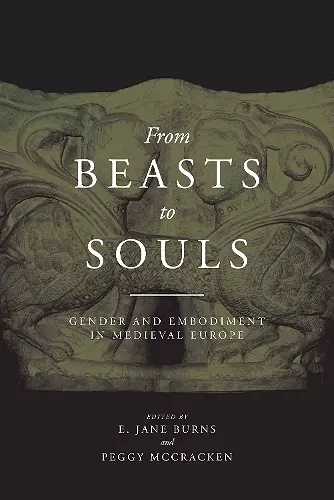From Beasts to Souls
Gender and Embodiment in Medieval Europe
Peggy McCracken editor E Jane Burns editor
Format:Paperback
Publisher:University of Notre Dame Press
Published:15th Apr '13
Currently unavailable, and unfortunately no date known when it will be back

The Middle Ages provides a particularly rich trove of hybrid creatures, semi-human beings, and composite bodies: we need only consider manuscript pages and stone capitals in Romanesque churches to picture the myriad figures incorporating both human and animal elements that allow movement between, and even confusion of, components of each realm.
From Beasts to Souls: Gender and Embodiment in Medieval Europe raises the issues of species and gender in tandem, asking readers to consider more fully what happens to gender in medieval representations of nonhuman embodiment. The contributors reflect on the gender of stones and the soul, of worms and dragons, showing that medieval cultural artifacts, whether literary, historical, or visual, do not limit questions of gender to predictable forms of human or semi-human embodiment. By expanding what counts as "the body" in medieval cultural studies, the essays shift our understanding of gendered embodiment and articulate new perspectives on its range, functions, and effects on a broader theoretical spectrum. Drawing on depictions of differently bodied creatures in the Middle Ages, they dislodge and reconfigure long-standing views of the body as always human and the human body as merely male and female.
The essays address a number of cultural contexts and academic disciplines: from French and English literature to objects of Germanic and Netherlandish material culture, from theological debates to literary concerns with the soul. They engage with issues of gender and embodiment located in stones, skeletons, and snake tails, swan-knights, and werewolves, along with a host of other unexpected places in a thought-provoking addition to somatic cultural history.
“This volume has everything to recommend it, not the least the list of contributors, some of the most enticing writers in the field. . . . Each article has a distinct theoretical profile, making it a collection of case studies on post-human gender from different perspectives. In this strong volume, every reader will find his or her preferred aspects.” —Modern Philology
“As a whole, the text offers a valuable contribution to the study of sex and gender in the medieval period by locating gender theory in relation to a diverse set of disciplinary and theoretical frames. . . . This collection offers a valuable contribution to medieval studies, gender studies, and new materialisms.” —Theology and Sexuality
“This superb, well-illustrated anthology well represents medieval cultural studies’ recent focus on animals and other nonhuman subjects. It attends chiefly to Middle English and French literature, with a welcome aside into medieval Christian doctrine. Its topics range from stones to mother’s milk, werewolves and lions, gendered souls, free-floating genitalia, and monstrous founding mothers, demonstrating the range of materials that become available to scholars once we cease to presume that humans are the only proper subject of our attention, or that the category of ‘the human’ is an already answered question.” —Arthuriana
“This collection is groundbreaking, not least for its intellectual generosity: in asking what happens to gender in narratives that challenge the boundaries of the human. Essays in this volume connect the driving questions of posthumanism to feminist, queer, and postcolonial methodologies.” —Studies in the Age of Chaucer
“This book certainly lives up to its promise to point to new directions of inquiry that a posthumanist perspective can provide, and it is easy to imagine many interesting discussions in graduate seminars where this text is adopted. . . . The questions raised here are wide-ranging and can be extended into other genres in literary studies and periods of history.” —Sixteenth Century Journal
“E. Jane Burns and Peggy McCracken take up the issue of post-humanism, most ably championed by Jeffrey J. Cohen, author of Medieval Identity. . . . Their scholarly goal is to look at medieval ‘representations of nonhuman or partially human creatures’ seeking insights into ‘gender and embodiment.’” —Parergon
“From Beasts to Souls takes up . . . questions about what happens to gender and sex in post- or nonhuman forms. The collection is theoretically savvy, both in its interactions with recent work in posthumanism, object-oriented ontology, and animal studies and in its use of theory to enable innovative readings of verbal and visual texts.” —Renaissance Quarterly
“. . . what happens to women and gender studies when theoretical attention moves away from the human? The authors of the essays have all published significant works related to women, gender and sexuality within the field of medieval studies. From Beasts to Souls reflects their interest in and concern about the recent development of posthumanism and animal studies.” —H-France Review
“This fascinating, timely book brings together eight essays by medievalist scholars on a wide range of medieval texts, artifacts, and images depicting strange bodies which trouble categories of both species and gender. From werewolves to copulating gemstones, from a corpse addressing the worms who devour it to animals who suckle human infants: the bodies that are scrutinized in these pages are a testament to the way in which medieval figures and stories can question and subvert ideas of convention and category.” —French Studies
“The anthology’s contributors are an elite group of illuminati, educated and employed at the best schools and representing a particular wisdom of the present age ‘to dislodge and reconfigure the long-standing constraints imposed by an understanding of the body as always human and of the human body as merely male and female.’” —Choice
ISBN: 9780268022327
Dimensions: 229mm x 152mm x 15mm
Weight: 381g
280 pages